Renewable Energies in the Agricultural Sector: A Perspective Analysis of the Last Three Years
Abstract
1. Introduction
2. Materials and Methods
Data Processing
- Worldwide search: Three fields were used in the Scopus search, i.e., (TITLE-ABS-KEY (renewable AND energ*) AND TITLE-ABS-KEY (agriculture)) AND PUBYEAR > 2017 AND PUBYEAR < 2022 AND PUBYEAR > 2017 AND PUBYEAR < 2022. The information was recorded as an excel file (.csv) and included information categories such as Years, Author, Document type, Cited by, Source, and Affiliation.
- Analysis was performed separately, with each data point receiving its own analysis using excel software version 2211.
- Clustering: information about authors, countries, and keywords was clustered using VOSviewer® software version 1.6.18, and the results provide information regarding scientific community/country collaborations and research trends through the use of keywords.
3. Results and Discussion
3.1. The Status of Research on Renewable Energy in the Agriculture Sector
3.2. Worldwide Publications on Renewable Energy in the Agriculture Sector
3.3. Worldwide Institution Distribution
3.4. Distribution of Publications
3.5. Most Cited Papers
3.6. Scientific Community and Keyword Analysis
4. Conclusions
Author Contributions
Funding
Data Availability Statement
Conflicts of Interest
References
- Objetivos de Desarrollo Sostenible. Available online: https://www.un.org/sustainabledevelopment/es/objetivos-de-desarrollo-sostenible/ (accessed on 5 November 2022).
- European Climate Law. Available online: https://eur-lex.europa.eu/legal-content/ES/TXT/?uri=CELEX%3A32021R1119 (accessed on 7 November 2022).
- Maraveas, C.; Loukatos, D.; Bartzanas, T.; Arvanitis, K.G.; Uijterwaal, J.F. Smart and solar greenhouse covers: Recent developments and future perspectives. Front. Energy Res. 2021, 9, 783587. [Google Scholar] [CrossRef]
- Popp, J.; Kovács, S.; Oláh, J.; Divéki, Z.; Balázs, E. Bioeconomy: Biomass and biomass-based energy supply and demand. New Biotechnol. 2021, 60, 76–84. [Google Scholar] [CrossRef]
- Ellis, E.C.; Ramankutty, N. Putting people in the map: Anthropogenic biomes of the world. Front. Ecol. Environ. 2008, 6, 439–447. [Google Scholar] [CrossRef]
- Garibaldi, L.A.; Pérez-Méndez, N. Positive outcomes between crop diversity and agricultural employment worldwide. Ecol. Econ. 2019, 164, 106358. [Google Scholar] [CrossRef]
- FAOSTAT. Available online: http://www.fao.org/faostat/en/#data/QC (accessed on 30 August 2019).
- Chen, C.; Park, T.; Wang, X.; Piao, S.; Xu, B.; Chaturvedi, R.K.; Fuchs, R.; Brovkin, V.; Ciais, P.; Fensholt, R.; et al. China and India lead in greening of the world through land-use management. Nat. Sustain. 2019, 2, 122–129. [Google Scholar] [CrossRef]
- Kissinger, G.; Herold, M.; de Sy, V. Drivers of Deforestation and Forest Degradation: A Synthesis Report for REDD+ Policymaker; Lexeme Consulting: Vancouver, BC, Canada, 2012; p. 48. [Google Scholar]
- Deforestation and Forest Degradation|Threats|WWF. Available online: https://www.worldwildlife.org/threats/deforestation-and-forest-degradation (accessed on 3 September 2019).
- Powell, J.W.; Welsh, J.M.; Pannell, D.; Kingwell, R. Can applying renewable energy for Australian sugarcane irrigation reduce energy cost and environmental impacts? A case study approach. J. Clean. Prod. 2019, 240, 118177. [Google Scholar] [CrossRef]
- Crespo Chacón, M.; Rodríguez Díaz, J.A.; García Morillo, J.; McNabola, A. Pump-as-Turbine Selection Methodology for Energy Recovery in Irrigation Networks: Minimising the Payback Period. Water 2019, 11, 149. [Google Scholar] [CrossRef]
- Noorollahi, Y.; Janalizadeh, H.; Yousefi, H.; Jahangir, M.H. Biofuel for energy self-sufficiency in agricultural sector of iran. Sustain. Energy Technol. Assess. 2021, 44, 101069. [Google Scholar] [CrossRef]
- Huo, L.; Zhao, L.; Yao, Z.; Luo, J.; Zhang, P.; Xie, T.; Wei, X. Potentiality of agricultural biomass energy for greenhouse gas emission reduction. Trans. Chin. Soc. Agric. Eng. 2021, 37, 179–187. [Google Scholar] [CrossRef]
- Degli Esposti, M.; Morselli, D.; Fava, F.; Bertin, L.; Cavani, F.; Viaggi, D.; Fabbri, P. The role of biotechnology in the transition from plastics to bioplastics: An opportunity to reconnect global growth with sustainability. FEBS Open Bio 2021, 11, 967–983. [Google Scholar] [CrossRef]
- Khan, Z.A.; Imran, M.; Umer, J.; Ahmed, S.; Diemuodeke, O.E.; Abdelatif, A.O. Assessing Crop Water Requirements and a Case for Renewable-Energy-Powered Pumping System for Wheat, Cotton, and Sorghum Crops in Sudan. Energies 2021, 14, 8133. [Google Scholar] [CrossRef]
- Riahi, J.; Vergura, S.; Mezghani, D.; Mami, A. Smart and Renewable Energy System to Power a Temperature-Controlled Greenhouse. Energies 2021, 14, 5499. [Google Scholar] [CrossRef]
- Nordberg, E.J.; Caley, M.J.; Schwarzkopf, L. Designing solar farms for synergistic commercial and conservation outcomes. Solar Energy 2021, 228, 586–593. [Google Scholar] [CrossRef]
- Páez, C.F.T.; Salazar, O.V. Analysis of biofuel production in ecuador from the perspective of the water-food-energy nexus. Energy Policy 2021, 157, 112496. [Google Scholar] [CrossRef]
- Weselek, A.; Bauerle, A.; Zikeli, S.; Lewandowski, I.; Högy, P. Effects on Crop Development, Yields and Chemical Composition of Celeriac (Apium graveolens L. var. rapaceum) Cultivated Underneath an Agrivoltaic System. Agronomy 2021, 11, 733. [Google Scholar] [CrossRef]
- Weselek, A.; Bauerle, A.; Hartung, J.; Zikeli, S.; Lewandowski, I.; Högy, P. Agrivoltaic system impacts on microclimate and yield of different crops within an organic crop rotation in a temperate climate. Agron. Sustain. Dev. 2021, 41, 59. [Google Scholar] [CrossRef]
- Kim, S.; Kim, S. Performance Estimation Modeling via Machine Learning of an Agrophotovoltaic System in South Korea. Energies 2021, 14, 6724. [Google Scholar] [CrossRef]
- European Environment Agency. Available online: https://www.eea.europa.eu/ (accessed on 9 November 2022).
- Ocak, S.; Acar, S. Biofuels from wastes in marmara region, turkey: Potentials and constraints. Environ. Sci. Pollut. Res. 2021, 28, 66026–66042. [Google Scholar] [CrossRef]
- Moustakas, K.; Sotiropoulos, D.; Vakalis, S. Evaluation of the biogas potential of agricultural biomass waste for energy applications in greece: A case study of the western greece region. Waste Manag. Res. 2021, 39, 438–447. [Google Scholar] [CrossRef]
- Alnhoud, O.T.; Al-Harahsheh, A.M.; Al-Harahsheh, M.S.; Irshaid, F.I. Animal solid waste as a potential renewable biomass energy source: A case study of jordan. Biomass Convers. Biorefinery 2021, 1–10. [Google Scholar] [CrossRef]
- Perea-Moreno, M.-A.; Sameron-Manzano, E.; Perea-Moreno, A.-J. Biomass as Renewable Energy: Worldwide Research Trends. Sustainability 2019, 11, 863. [Google Scholar] [CrossRef]
- Salmeron-Manzano, E.; Manzano-Agugliaro, F. The Higher Education Sustainability through Virtual Laboratories: The Spanish University as Case of Study. Sustainability 2018, 10, 4040. [Google Scholar] [CrossRef]
- Brown, T.; Gutman, S.A. Impact factor, eigenfactor, article influence, scopus SNIP, and SCImage journal rank of occupational therapy journals. Scand. J. Occup. Ther. 2019, 26, 475–483. [Google Scholar] [CrossRef] [PubMed]
- Ortega-Ballesteros, A.; Manzano-Agugliaro, F.; Perea-Moreno, A.-J. Water Utilities Challenges: A Bibliometric Analysis. Sustainability 2021, 13, 7726. [Google Scholar] [CrossRef]
- Knapczyk, A.; Francik, S.; Jewiarz, M.; Zawiślak, A.; Francik, R. Thermal Treatment of Biomass: A Bibliometric Analysis—The Torrefaction Case. Energies 2021, 14, 162. [Google Scholar] [CrossRef]
- Liu, L.; Guo, X.; Lee, C. Promoting smart cities into the 5G era with multi-field internet of things (IoT) applications powered with advanced mechanical energy harvesters. Nano Energy 2021, 88, 106304. [Google Scholar] [CrossRef]
- Woźniak, W.; Jessa, M. Selection of Solar Powered Unmanned Aerial Vehicles for a Long Range Data Acquisition Chain. Sensors 2021, 21, 2772. [Google Scholar] [CrossRef]
- Al-Mamun, G.M.S.U.; Hossain, M.I.; Hasan, M.R.; Rahman, A.; D’Costa, S.M.; Hossain, A.J.; Hoque, A. Performance analysis of multipurpose AGROBOT. In Proceedings of the 2019 5th IEEE International WIE Conference on Electrical and Computer Engineering, WIECON-ECE 2019, Bangalore, India, 15–16 November 2019. [Google Scholar] [CrossRef]
- Salvilla, J.N.V.; Ofrasio, B.I.G.; Rollon, A.P.; Manegdeg, F.G.; Abarca, R.R.M.; de Luna, M.D.G. Synergistic co-pyrolysıs of polyolefin plastics with wood and agricultural wastes for biofuel production. Appl. Energy 2020, 279, 115668. [Google Scholar] [CrossRef]
- Gonzaga Fraga, L.; Carlos, F.; Teixeira, J.; Eduardo, C.; Ferreira, M. The Potential of Renewable Energy in Timor-Leste: An Assessment for Biomass. Energies 2019, 12, 1441. [Google Scholar] [CrossRef]
- Oh, K.C.; Park, S.Y.; Kim, S.J.; Choi, Y.S.; Lee, C.G.; Cho, L.H.; Kim, D.H. Development and validation of mass reduction model to optimize torrefaction for agricultural byproduct biomass. Renew. Energy 2019, 139, 988–999. [Google Scholar] [CrossRef]
- Alatzas, S.; Moustakas, K.; Malamis, D.; Vakalis, S. Biomass Potential from Agricultural Waste for Energetic Utilization in Greece. Energies 2019, 12, 1095. [Google Scholar] [CrossRef]
- Danish; Baloch, M.A.; Mahmood, N.; Zhang, J.W. Effect of natural resources, renewable energy and economic development on CO2 emissions in BRICS countries. Sci. Total Environ. 2019, 678, 632–638. [Google Scholar] [CrossRef]
- Romanello, M.; McGushin, A.; di Napoli, C.; Drummond, P.; Hughes, N.; Jamart, L.; Kennard, H.; Lampard, P.; Rodriquez, B.S.; Arnell, N.; et al. The 2021 report of the Lancet Countdown on health and climate change: Code red for a healthy future. Lancet 2021, 398, 1619–1662. [Google Scholar] [CrossRef] [PubMed]
- Sekoai, P.T.; Ouma, C.N.M.; Du Preez, S.P.; Modisha, P.; Engelbrecht, N.; Bessarabov, D.G.; Ghimire, A. Application of nanoparticles in biofuels: An overview. Fuel 2019, 237, 380–397. [Google Scholar] [CrossRef]
- Qiao, H.; Zheng, F.; Jiang, H.; Dong, K. The greenhouse effect of the agriculture-economic growth-renewable energy nexus: Evidence from G20 countries. Sci. Total Environ. 2019, 671, 722–731. [Google Scholar] [CrossRef] [PubMed]
- Barron-Gafford, G.A.; Pavao-Zuckerman, M.A.; Minor, R.L.; Sutter, L.F.; Barnett-Moreno, I.; Blackett, D.T.; Thompson, M.; Dimond, K.; Gerlak, A.K.; Nabhan, G.P.; et al. Agrivoltaics provide mutual benefits across the food–energy–water nexus in drylands. Nat. Sustain. 2019, 2, 848–855. [Google Scholar] [CrossRef]
- Sherwood, J. The significance of biomass in a circular economy. Bioresour. Technol. 2020, 300, 122755. [Google Scholar] [CrossRef]
- Elkadeem, M.R.; Wang, S.; Sharshir, S.W.; Atia, E.G. Feasibility analysis and techno-economic design of grid-isolated hybrid renewable energy system for electrification of agriculture and irrigation area: A case study in Dongola, Sudan. Energy Convers. Manag. 2019, 196, 1453–1478. [Google Scholar] [CrossRef]
- Pata, U.K. Linking renewable energy, globalization, agriculture, CO2 emissions and ecological footprint in BRIC countries: A sustainability perspective. Renew. Energy 2021, 173, 197–208. [Google Scholar] [CrossRef]
- Weselek, A.; Ehmann, A.; Zikeli, S.; Lewandowski, I.; Schindele, S.; Högy, P. Agrophotovoltaic systems: Applications, challenges, and opportunities. A review. Agron. Sustain. Dev. 2019, 39, 35. [Google Scholar] [CrossRef]
- Taghizadeh-Hesary, F.; Rasoulinezhad, E.; Yoshino, N. Energy and food security: Linkages through price volatility. Energy Policy 2019, 128, 796–806. [Google Scholar] [CrossRef]
- Ikram, M.; Zhang, Q.; Sroufe, R.; Shah, S.Z.A. Towards a sustainable environment: The nexus between ISO 14001, renewable energy consumption, access to electricity, agriculture and CO2 emissions in SAARC countries. Sustain. Prod. Consum. 2020, 22, 218–230. [Google Scholar] [CrossRef]
- Usman, M.; Makhdum, M.S.A. What abates ecological footprint in BRICS-T region? Exploring the influence of renewable energy, non-renewable energy, agriculture, forest area and financial development. Renew. Energy 2021, 179, 12–28. [Google Scholar] [CrossRef]
- Ridzuan, N.H.A.M.; Marwan, N.F.; Khalid, N.; Ali, M.H.; Tseng, M.L. Effects of agriculture, renewable energy, and economic growth on carbon dioxide emissions: Evidence of the environmental Kuznets curve. Resour. Conserv. Recycl. 2020, 160, 104879. [Google Scholar] [CrossRef]
- Aydoğan, B.; Vardar, G. Evaluating the role of renewable energy, economic growth and agriculture on CO2 emission in E7 countries. Int. J. Sustain. Energy 2020, 39, 335–348. [Google Scholar] [CrossRef]
- Wang, B.; Song, J.; Ren, J.; Li, K.; Duan, H. Selecting sustainable energy conversion technologies for agricultural residues: A fuzzy AHP-VIKOR based prioritization from life cycle perspective. Resour. Conserv. Recycl. 2019, 142, 78–87. [Google Scholar] [CrossRef]
- Yao, Y.; Huang, G.; An, C.; Chen, X.; Zhang, P.; Xin, X.; Agnew, J. Anaerobic digestion of livestock manure in cold regions: Technological advancements and global impacts. Renew. Sust. Energy Rev. 2020, 119, 109494. [Google Scholar] [CrossRef]
- Antoniou, N.; Monlau, F.; Sambusiti, C.; Ficara, E.; Barakat, A.; Zabaniotou, A. Contribution to Circular Economy options of mixed agricultural wastes management: Coupling anaerobic digestion with gasification for enhanced energy and material recovery. J. Clean. Prod. 2019, 209, 505–514. [Google Scholar] [CrossRef]
- McDougall, R.; Kristiansen, P.; Rader, R. Small-scale urban agriculture results in high yields but requires judicious management of inputs to achieve sustainability. Proc. Natl. Acad. Sci. USA 2019, 116, 129–134. [Google Scholar] [CrossRef]
- Aziz, N.; Sharif, A.; Raza, A.; Rong, K. Revisiting the role of forestry, agriculture, and renewable energy in testing environment Kuznets curve in Pakistan: Evidence from Quantile ARDL approach. Environ. Sci. Pollut. Res. 2020, 27, 10115–10128. [Google Scholar] [CrossRef]
- Sharma, G.D.; Shah, M.I.; Shahzad, U.; Jain, M.; Chopra, R. Exploring the nexus between agriculture and greenhouse gas emissions in BIMSTEC region: The role of renewable energy and human capital as moderators. J. Environ. Manag. 2021, 297, 113316. [Google Scholar] [CrossRef] [PubMed]
- Alcayde, A.; Montoya, F.G.; Baños, R.; Perea-Moreno, A.-J.; Manzano-Agugliaro, F. Analysis of Research Topics and Scientific Collaborations in Renewable Energy Using Community Detection. Sustainability 2018, 10, 4510. [Google Scholar] [CrossRef]
- De la Cruz-Lovera, C.; Perea-Moreno, A.-J.; de la Cruz-Fernández, J.-L.; Alvarez-Bermejo, J.A.; Manzano-Agugliaro, F. Worldwide Research on Energy Efficiency and Sustainability in Public Buildings. Sustainability 2017, 9, 1294. [Google Scholar] [CrossRef]

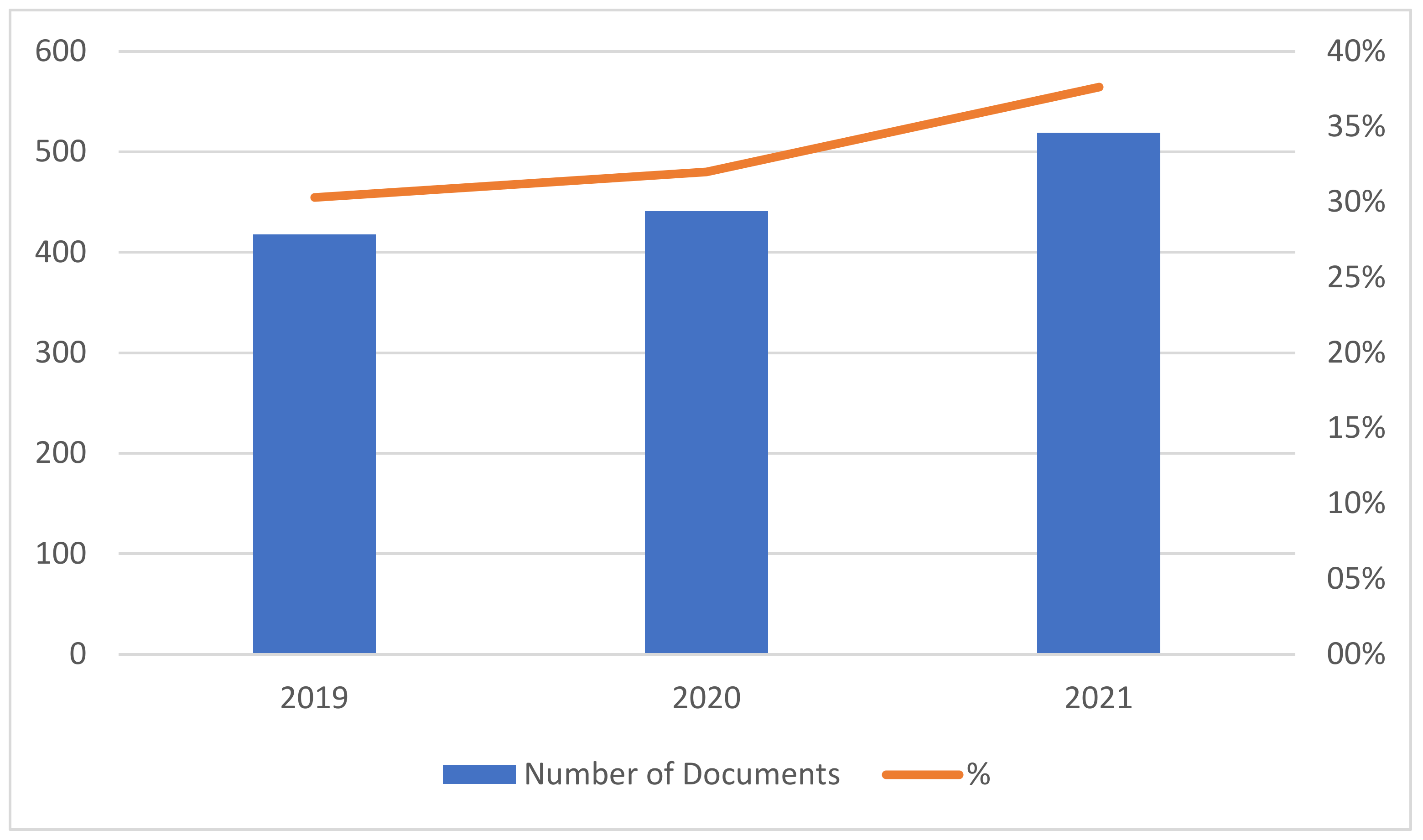

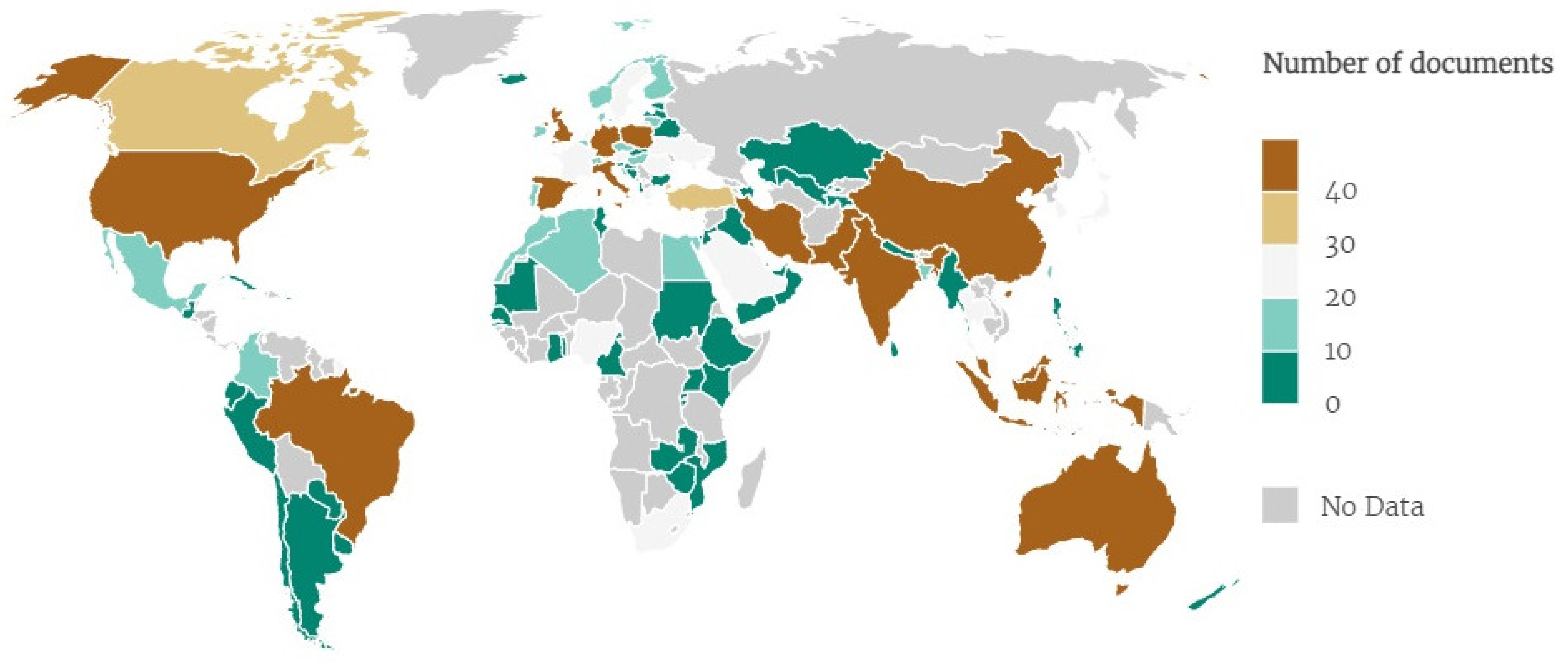
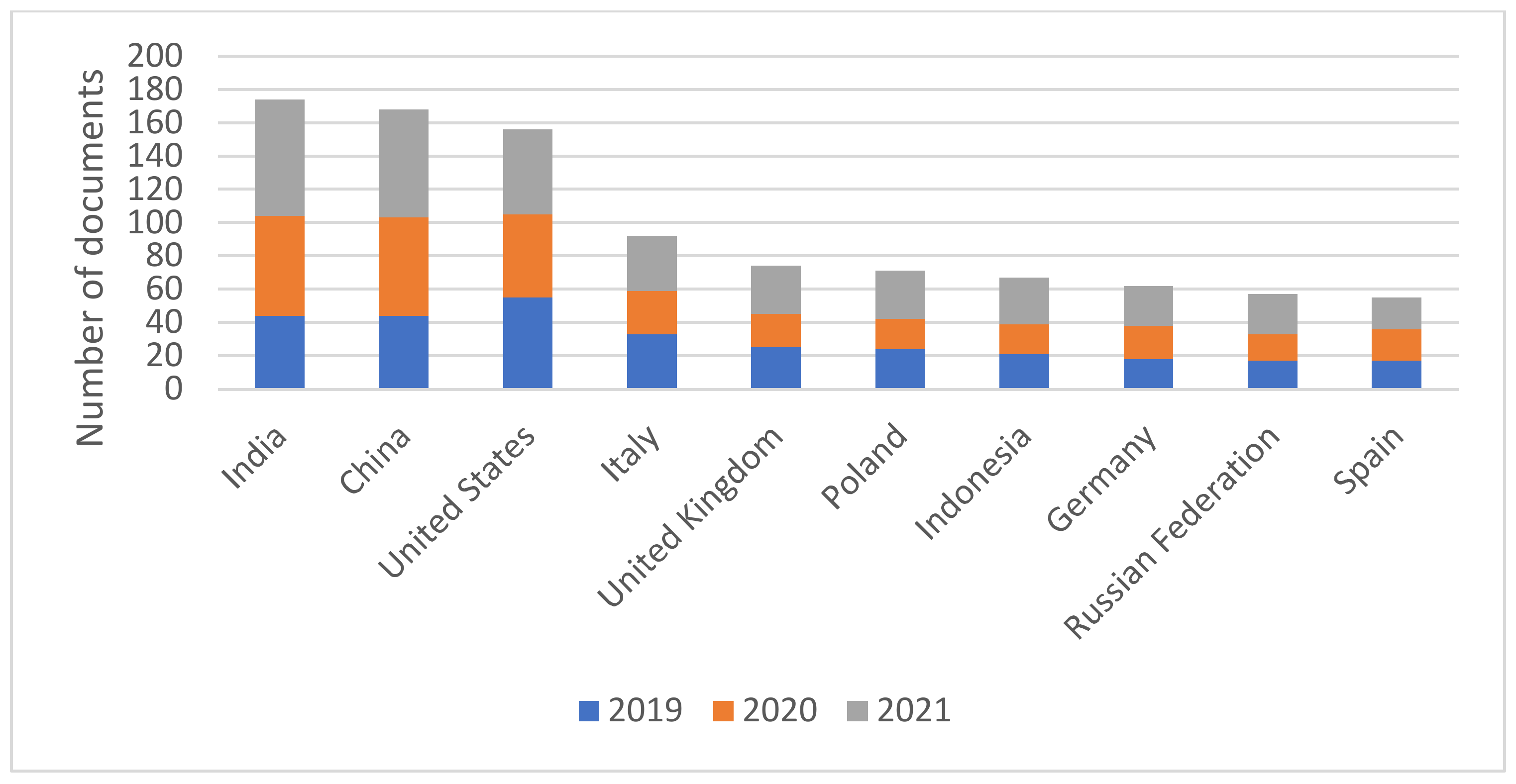
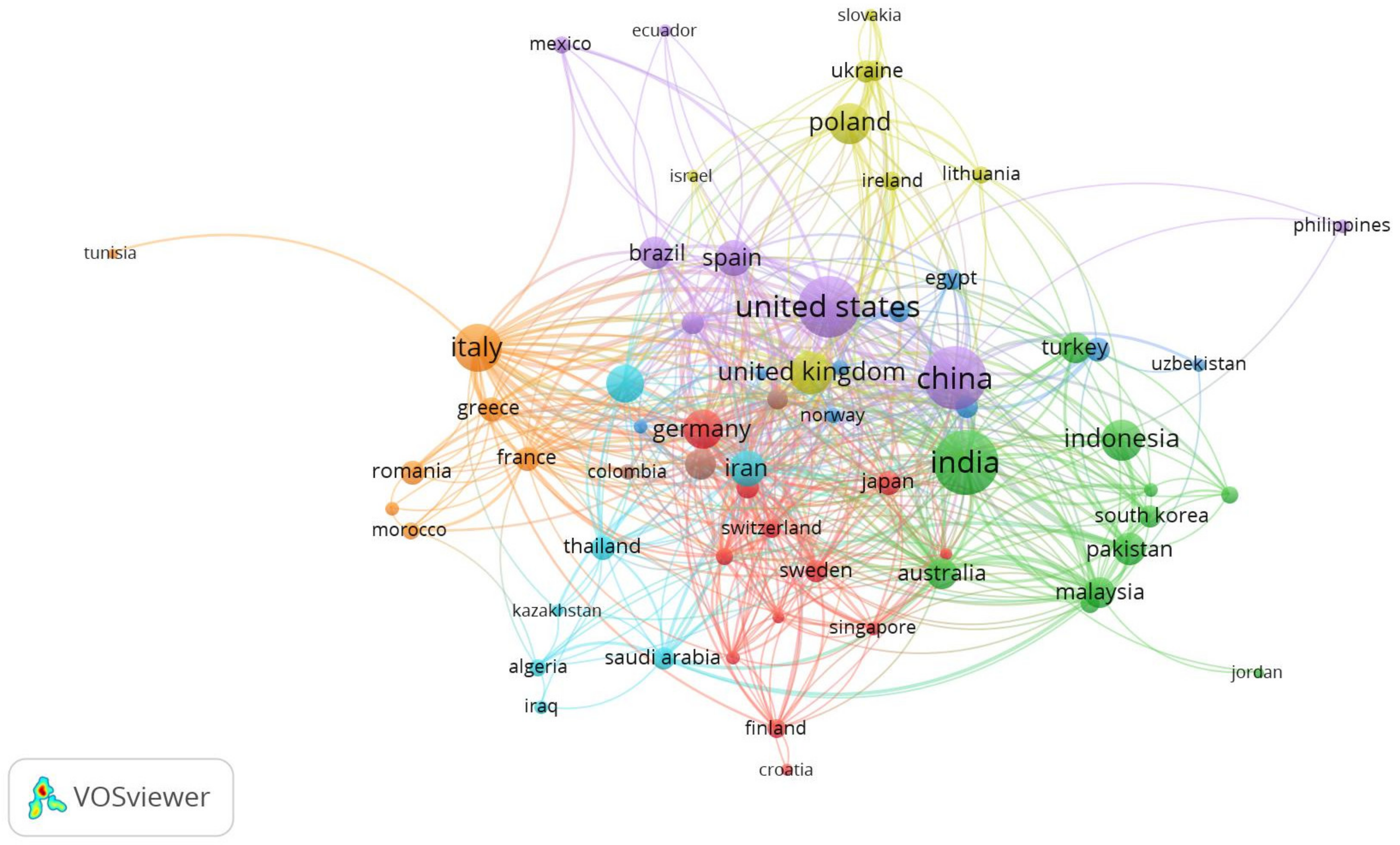
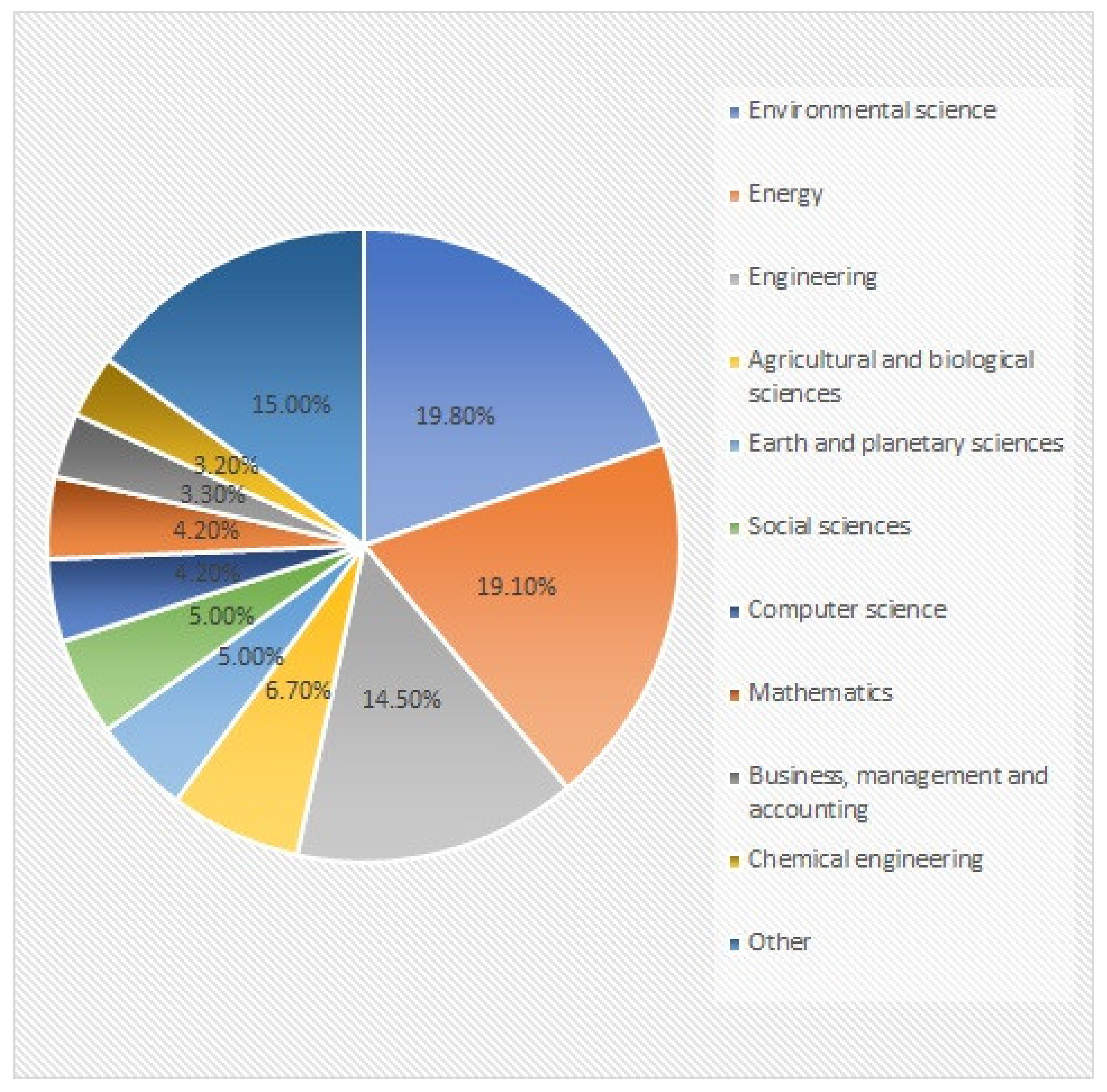
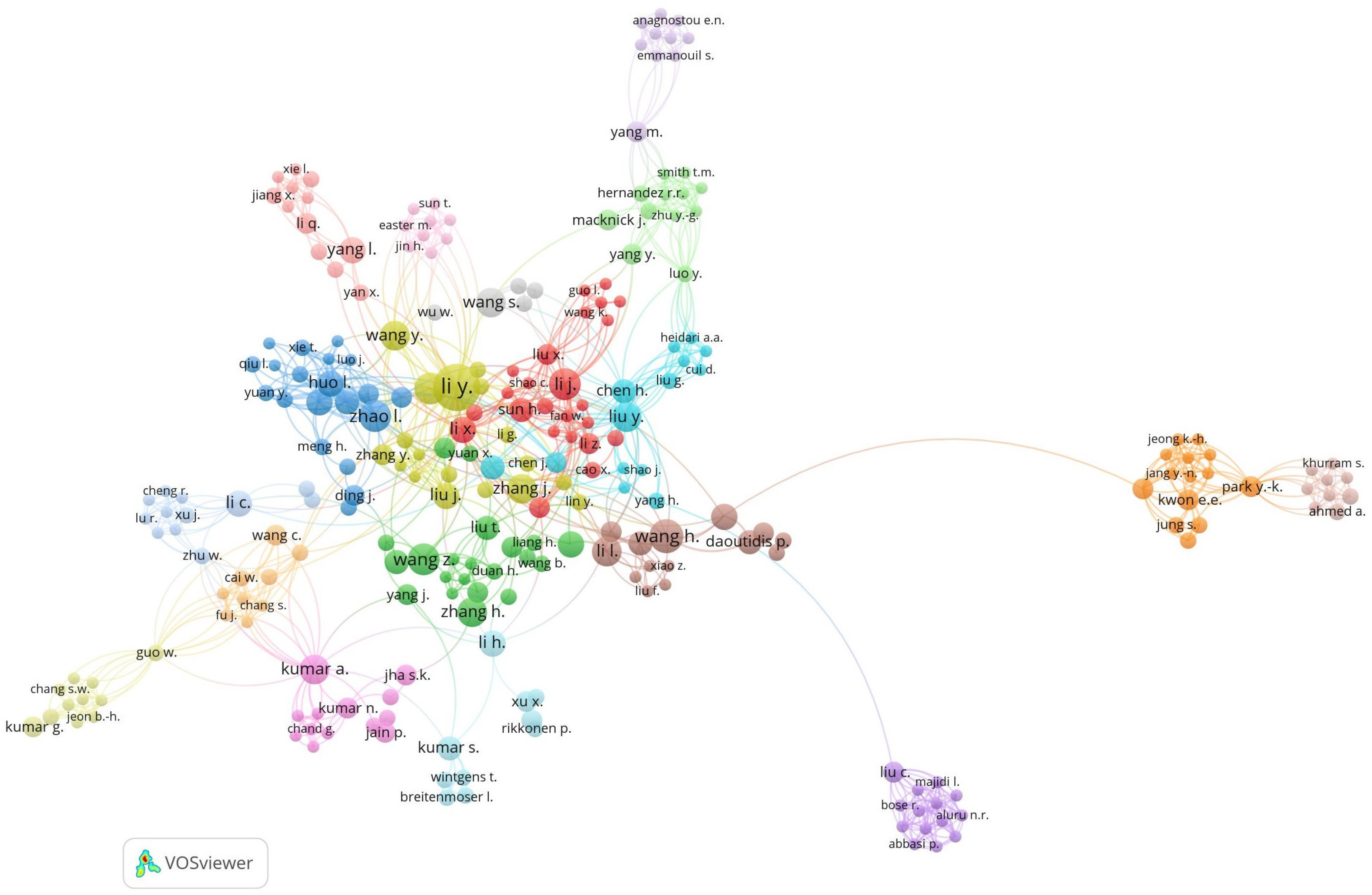
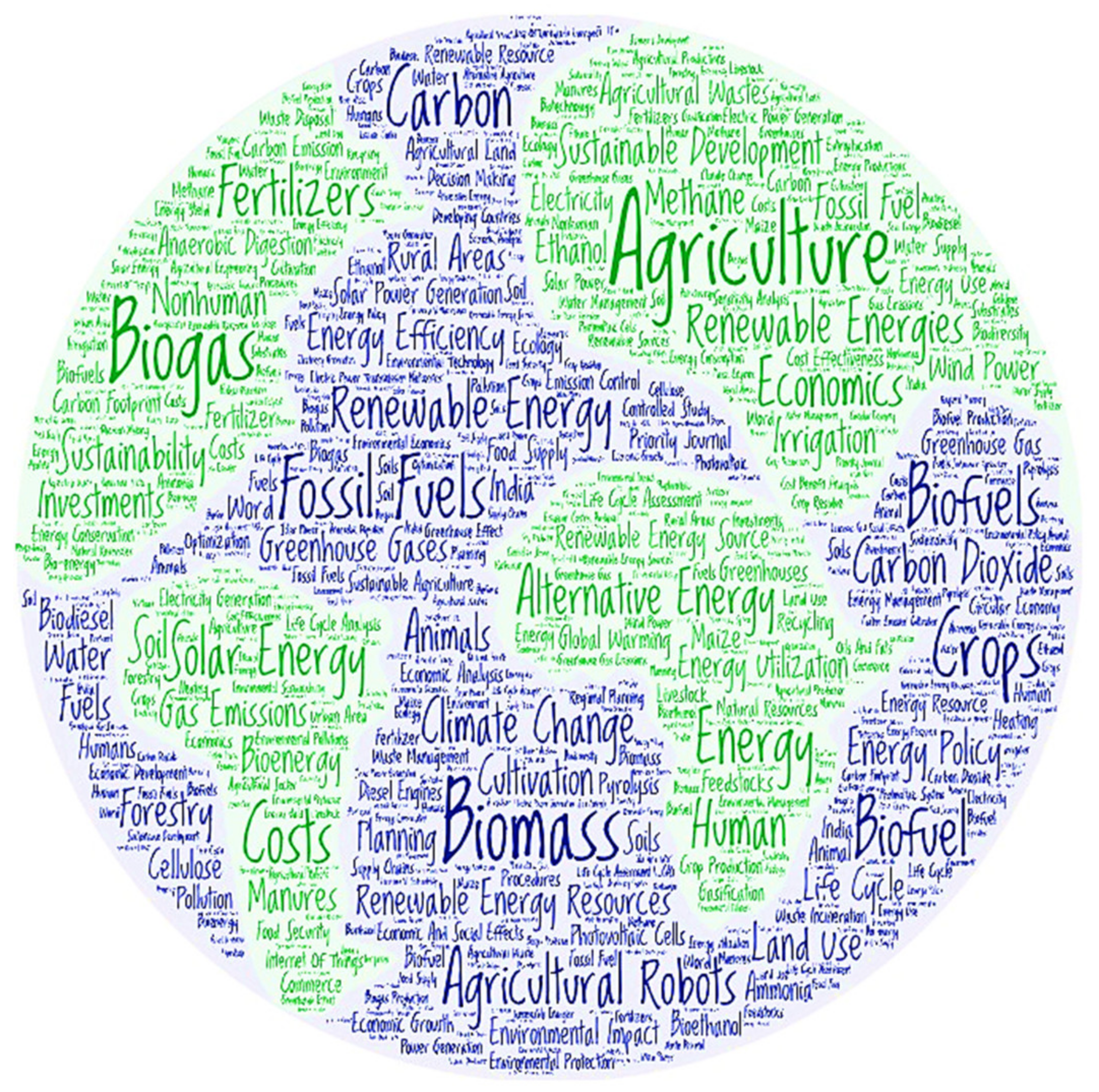
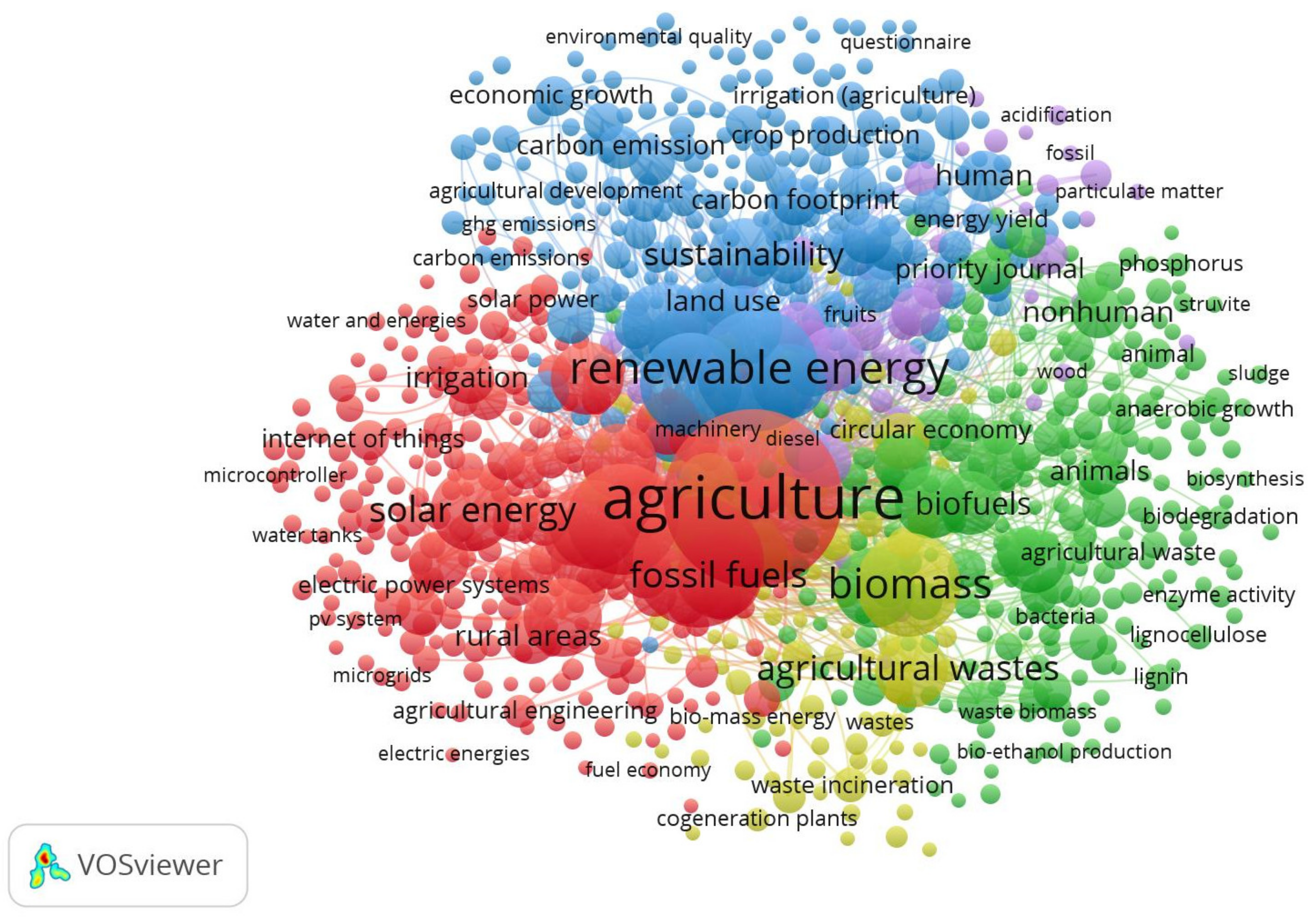
| Cluster | Color | Countries |
|---|---|---|
| 1 | Red | Austria, Croatia, Denmark, Finland, Germany, Japan, Kenya, New Zealand, Singapore, Sweden, Switzerland, United Arab Emirates. |
| 2 | Green | Australia, Bangladesh, India, Indonesia, Jordan, Malaysia, Pakistan, South Korea, Taiwan, Turkey, Vietnam. |
| 3 | Blue | Chile, Egypt, Hungary, Nigeria, Norway, Portugal, Serbia, South Africa, Uzbekistan. |
| 4 | Yellow | Czech Republic, Ireland, Israel, Lithuania, Poland, Slovakia, Ukraine, United Kingdom. |
| 5 | Purple | Brazil, China, Ecuador, Mexico, Netherlands, Philippines, Spain, United States. |
| 6 | Turquoise | Algeria, Iran, Iraq, Kazakhstan, Russian Federation, Saudi Arabia, Thailand. |
| 7 | Orange | Bulgaria, France, Greece, Italy, Morocco, Romania, Tunisia. |
| 8 | Brown | Belgium, Canada, Colombia. |
| Institution | Documents | Country | Keywords Most Used | |
|---|---|---|---|---|
| 1 | 2 | |||
| Chinese Ministry of Education | 18 | China | Agricultural Wastes | Biomass |
| University of Tehran | 13 | Iran | Agriculture | Agricultural Robots |
| China Agricultural University | 12 | China | Agricultural Robots | Sustainability |
| China Academy of Sciences | 12 | China | Alternative Energy | Agricultural Robots |
| Wageningen University and Research | 11 | Netherlands | Renewable Energy | Climate Change |
| Imperial College London | 11 | United Kingdom | Fossil Fuel | Agricultural Robots |
| Norwest A&F University | 10 | China | Agriculture Robots | Alternative Energy |
| Universidade de Sao Paulo | 9 | Brazil | Agriculture Robots | Agriculture |
| Universitat Autònoma de Barcelona | 9 | Spain | Agriculture | Renewable Energies |
| Uniwerytet Warmisko-Mazurski w Olsztynie | 9 | Poland | Agriculture Robots | Biomass |
| Journal | Quartile | SRJ | H-Index | JCR | Total Documents | Total Cites | Country |
|---|---|---|---|---|---|---|---|
| Energies | Q1 (SJR) | 0.653 | 111 | 3.252 | 57 | 76,498 | Switzerland |
| Journal of Cleaner Production | Q1 (SJR) | 1.921 | 232 | 11.072 | 51 | 250,231 | United Kingdom |
| Renewable and Sustainable Energy Reviews | Q1 (SJR) | 3.768 | 337 | 16.799 | 32 | 162,005 | United Kingdom |
| Science of the Total Environment | Q1 (SJR) | 1.806 | 275 | 10.754 | 31 | 328,230 | Netherlands |
| Renewable Energy | Q1 (SJR) | 1.877 | 210 | 8.634 | 30 | 95,713 | United Kingdom |
| Sustainability | Q1 (SJR) | 0.664 | 109 | 3.889 | 30 | 130,266 | Switzerland |
| Environmental Science and Pollution Research | Q1 (SJR) | 0.831 | 132 | 5.190 | 22 | 110,000 | Germany |
| Applied Sciences | Q2 (SJR) | 0.507 | 75 | 2.838 | 4 | 63,761 | Switzerland |
| Clean Technologies and Environmental Policy | Q1 (SJR) | 0.756 | 62 | 4.700 | 4 | 6258 | Germany |
| Energy Reports | Q1 (SJR) | 0.894 | 49 | 4.937 | 4 | 8369 | United Kingdom |
| Document Title | Year | Journal | Cited by | Reference |
|---|---|---|---|---|
| Effect of natural resources, renewable energy and economic development on CO2 emissions in BRICS countries | 2019 | Science of the Total Environment | 338 | [39] |
| The 2021 report of the Lancet Countdown on health and climate change: code red for a healthy future | 2021 | The Lancet | 205 | [40] |
| Application of nanoparticles in biofuels: An overview | 2019 | Fuel | 162 | [41] |
| The greenhouse effect of the agriculture-economic growth-renewable energy nexus: Evidence from G20 countries | 2019 | Science of the Total Environment | 159 | [42] |
| Agrivoltaics provide mutual benefits across the food–energy–water nexus in drylands | 2019 | Nature Sustainability | 151 | [43] |
| The significance of biomass in a circular economy | 2020 | Bioresource Technology | 143 | [44] |
| Feasibility analysis and techno-economic design of grid-isolated hybrid renewable energy system for electrification of agriculture and irrigation area: A case study in Dongola, Sudan | 2019 | Energy Conversion and Management | 133 | [45] |
| Linking renewable energy, globalization, agriculture, CO2 emissions and ecological footprint in BRIC countries: A sustainability perspective | 2021 | Renewable Energy | 125 | [46] |
| Agrophotovoltaic systems: applications, challenges, and opportunities. A review | 2019 | Agronomy for Sustainable Development | 119 | [47] |
| Energy and Food Security: Linkages through Price Volatility | 2019 | Energy Policy | 112 | [48] |
| Towards a sustainable environment: The nexus between ISO 14001, renewable energy consumption, access to electricity, agriculture and CO2 emissions in SAARC countries | 2020 | Sustainable Production and Consumption | 107 | [49] |
| What abates ecological footprint in BRICS-T region? Exploring the influence of renewable energy, non-renewable energy, agriculture, forest area and financial development | 2021 | Renewable Energy | 105 | [50] |
| Effects of agriculture, renewable energy, and economic growth on carbon dioxide emissions: Evidence of the environmental Kuznets curve | 2020 | Resources, Conservation and Recycling | 100 | [51] |
| Evaluating the role of renewable energy, economic growth and agriculture on CO2 emission in E7 countries | 2020 | International Journal of Sustainable Energy | 100 | [52] |
| Selecting sustainable energy conversion technologies for agricultural residues: A fuzzy AHP-VIKOR based prioritization from life cycle perspective | 2019 | Resources, Conservation and Recycling | 99 | [53] |
| Anaerobic digestion of livestock manure in cold regions: Technological advancements and global impacts | 2020 | Renewable and Sustainable Energy Reviews | 88 | [54] |
| Contribution to Circular Economy options of mixed agricultural wastes management: Coupling anaerobic digestion with gasification for enhanced energy and material recovery | 2019 | Journal of Cleaner Production | 88 | [55] |
| Small-scale urban agriculture results in high yields but requires judicious management of inputs to achieve sustainability | 2019 | Proceedings of the National Academy of Sciences of the United States of America | 88 | [56] |
| Revisiting the role of forestry, agriculture, and renewable energy in testing environment Kuznets curve in Pakistan: evidence from Quantile ARDL approach | 2020 | Environmental Science and Pollution Research | 86 | [57] |
| Exploring the nexus between agriculture and greenhouse gas emissions in BIMSTEC region: The role of renewable energy and human capital as moderators | 2021 | Journal of Environmental Management | 82 | [58] |
| Author | No. of Documents in the Last Three Years | Affiliation | H-Index | Country | Investigation Line |
|---|---|---|---|---|---|
| Zhao, L. | 6 | Ministry of Agriculture of the People’s Republic of China | 23 | China | Agricultural biomass for energy |
| Huo, L. | 5 | Ministry of Agriculture of the People’s Republic of China | 12 | China | Agricultural biomass for energy |
| Kodirov, D. | 5 | Tashkent Institute of Irrigation and Agricultural Mechanization Engineers at the National Research University of Uzbekistan | 9 | Uzbekistan | Renewable energy technologies in the agricultural sector |
| Yao, Z. | 5 | Chinese Academy of Agricultural Sciences | 17 | China | Agricultural biomass for energy |
| Daoutidis, P. | 4 | University of Minnesota, Twin Cities | 11 | USA | Renewable energy systems in agriculture |
| Cluster | Color | Main Keywords | Topic |
|---|---|---|---|
| 1 | Red | Agriculture Robots, Solar Energy, Renewable Energy Sources, Energy Utilization, Irrigation. | Agriculture–Renewable energy |
| 2 | Green | Biogas, Waste Management, Pyrolysis, Biofuel, Bioconversion. | Bioenergy |
| 3 | Blue | Renewable Energy, Alternative Energy, Sustainability, Crop Production, Carbon Dioxide. | Sustainable Agriculture |
| 4 | Yellow | Biomass, Agricultural Wastes, Bioenergy, Gas Emissions, Biomass Power. | Biomass Energy |
| 5 | Purple | Environmental Impact, Global Warming, Life Cycle, Greenhouse Gas Emissions, Fertilizer. | Environmental Impact of Agriculture |
Disclaimer/Publisher’s Note: The statements, opinions and data contained in all publications are solely those of the individual author(s) and contributor(s) and not of MDPI and/or the editor(s). MDPI and/or the editor(s) disclaim responsibility for any injury to people or property resulting from any ideas, methods, instructions or products referred to in the content. |
© 2022 by the authors. Licensee MDPI, Basel, Switzerland. This article is an open access article distributed under the terms and conditions of the Creative Commons Attribution (CC BY) license (https://creativecommons.org/licenses/by/4.0/).
Share and Cite
Hernandez-Escobedo, Q.; Muñoz-Rodríguez, D.; Vargas-Casillas, A.; Juárez Lopez, J.M.; Aparicio-Martínez, P.; Martínez-Jiménez, M.P.; Perea-Moreno, A.-J. Renewable Energies in the Agricultural Sector: A Perspective Analysis of the Last Three Years. Energies 2023, 16, 345. https://doi.org/10.3390/en16010345
Hernandez-Escobedo Q, Muñoz-Rodríguez D, Vargas-Casillas A, Juárez Lopez JM, Aparicio-Martínez P, Martínez-Jiménez MP, Perea-Moreno A-J. Renewable Energies in the Agricultural Sector: A Perspective Analysis of the Last Three Years. Energies. 2023; 16(1):345. https://doi.org/10.3390/en16010345
Chicago/Turabian StyleHernandez-Escobedo, Quetzalcoatl, David Muñoz-Rodríguez, Alejandro Vargas-Casillas, José Manuel Juárez Lopez, Pilar Aparicio-Martínez, María Pilar Martínez-Jiménez, and Alberto-Jesus Perea-Moreno. 2023. "Renewable Energies in the Agricultural Sector: A Perspective Analysis of the Last Three Years" Energies 16, no. 1: 345. https://doi.org/10.3390/en16010345
APA StyleHernandez-Escobedo, Q., Muñoz-Rodríguez, D., Vargas-Casillas, A., Juárez Lopez, J. M., Aparicio-Martínez, P., Martínez-Jiménez, M. P., & Perea-Moreno, A.-J. (2023). Renewable Energies in the Agricultural Sector: A Perspective Analysis of the Last Three Years. Energies, 16(1), 345. https://doi.org/10.3390/en16010345








